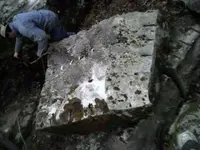There is an excellent book titled "The Pirate Hunter", by Richard Zachs, in which he tracks the log books and manifests of William Kidd's adventures. Much of the cargo from the ships he did capture (four) was bales of silks and fibers, 70 tons of sugar, and the rest split among the prize ships. And there is no time gap in the logs in which Kidd could have made it to Oak Island, let alone tunnel down an engineering marvel of a shaft.
Kidd never confessed to piracy and maintained his operations (to hunt unsanctioned privateers and ships chartered by France, then England's enemy) were fully sanctioned. He kept careful track of the cargo. Plenty of silver for sure, but that was seized by Gov. Bellmont and shipped to England (along with 260 pieces of eight of Mrs. Kidd's personal household silver and cash on hand {"Plate and money"}).
The Gardnier's Island "treasure" was valued at 14,000 British Pounds Sterling, which would have been Kidd's share plus the shares for the backers of the expedition - the rest having been divided earlier with the three crews. By the time of Kidd's trial the story was he had carried 100,000 B. Pounds (partially helped along by Kidd who played along as a means out of a nasty prison - to get to go recover the portion of the treasure which he claimed had been LEFT AT ST. MARYS, MADAGASCAR, where the Adventure Galley sank) and he was villified by the four Lords who had secretly backed his expedition to insulate them from the pollitical mess his capture of two French chartered ships and the Quedagh Merchant from a country Britian then needed as an ally. They were further pissed that a true pirate (Cullliford) had recently captured the Great Mohammed, a pilgrim ship and demanded reperations on both from England. After the trial the British reimbursed the Cogi Baba, emissary to the Grand Mohgul, 891 British Pounds for the loss of cargo.
The rest was used to pay Christopher Wren to design and contractors to build Greenwich Hospital - a Naval hospital. That's the boring end of "Kidd's Treasure".




